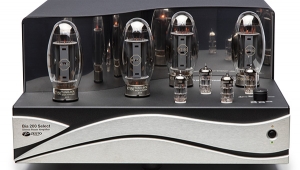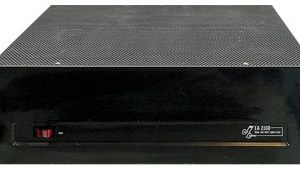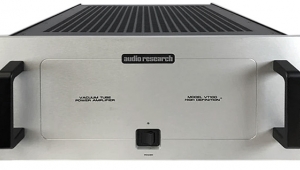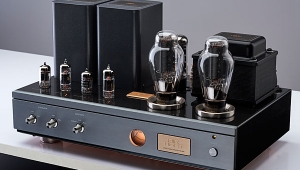| Columns Retired Columns & Blogs |
Cary Audio Design CAD-805 monoblock power amplifier Sam Tellig 3/98
Sam Tellig wrote about the CAD-805 in March 1998 (Vol.21 No.3):
Footnote 1: The 845 output tube is Chinese, and the 6SL7 driver tube is JAN (Joint Army Navy) Philips, made in the US.—Sam Tellig
It takes courage to buy an amp like the Cary CAD-805C—so retro in its technology and its look.
"You bought those," my friend Pavel said, referring to the CAD-805C monoblocks in my listening room. "Wait till I tell my friends back in Russia. We couldn't wait to get rid of tubes."
Ha-ha-ha.
Or kcha-kcha-kcha, as they say in Russia, there being no h in Russian. It is thus that Handel, Haydn, and Horowitz are transformed into Gandel, Gaydn, and Gorowitz. And Dennis Had, President of Cary Audio Design, becomes Dennis Kchad.
"Audiophiles in Russia know all about Dennis Kchad and the Cary CAD-805C," I assured Pavel. "In fact, Audio Magazine in St. Petersburg said that Cary is real high-end."
As Pavel continued to chuckle, I invited him to take a seat. With the amps well warmed up, I played a recording of Tchaikovsky's Symphony 4, with Gennady Rozhdestvensky conducting the London Symphony (IMP Classics PCD 867). Pavel stopped laughing.
"It's amazing," he said. "You're right there."
This is one of the pleasures of owning a pair of CAD-805Cs: playing them for Pavel. Or Slava, or Lev, or whomever. Hearing is believing, at least for some audiophiles. Audio critics are another matter—some have even taken to ranting against single-ended triodes.
There are just three tubes in the CAD-805C: a 6SL7 input tube, a 300B driver tube, and an 845 output tube. The 845 has a thoriated tungsten cathode—the tube glows white. A pair of them will light up a room enough that you won't stumble around in the dark.
Now supplied with new Western Electric 300B driver tubes as standard, a pair of Cary CAD-805Cs retails for $8995 (footnote 1). Cary claims the 805C will deliver 50W into 4, 8, or 16 ohms, and there are separate sets of speaker terminals—ie, output transformer taps—for each.
The tube complement has changed since the Cary 805C was introduced at the Las Vegas CES in January 1991, a year before the amp actually went into production. Then the output tube was the 805, hence the amp's name. The output tube has changed but the name hasn't. And the driver tube was an EL34 instead of a 300B. By the time Dick Olsher caught up with the amp two years later in the January 1994 Stereophile (Vol.17 No.1, p.104), the driver tube was still an EL34 but the output tube was a 211, as it was until the 805C of January 1997.
Dennis Had, designer of the amp, describes the power as "pure class-A1" up to 28W, and "class-A2" up to 50W.
Class-A2 takes over where class-A1 leaves off. The circuit's efficiency is increased by nearly 50%. Dennis explains:
"With only a capacitor coupling between the 300B and the 845, the output would be limited to 21-25W. The grid of the 845 goes down to a low impedance and you can't drive it any further. Unless..."
"Unless...?"
"Unless you use an interstage transformer. This transforms the impedance of the 300B to drive the grid of the 845 output tube. When you play the amp loud, it will draw positive grid current driven by the interstage transformer. The interstage transformer makes the amplifier circuit very efficient."
In other words, the cathode-based 845 tube draws no grid current in class-A1. Drive the amp harder and the 845's grid goes positive, drawing current via the interstage transformer that couples the 300B and the 845. With class-A2, however, comes increased distortion—one reason to avoid highly inefficient, difficult-to-drive speakers with the Cary CAD-805C. Nevertheless, with the CAD-805C, you're far less limited than you are with a single-ended triode amp using a single 300B output tube, where you're limited to around 10-12W max.
But power ratings can be misleading, especially with single-ended triode amps. Compared to a typical 50Wpc stereo tube amp, for instance, the CAD-805C sounds big. Humongous, in fact. As Pavel heard, you do get your $9k worth of sound.
No, you don't get the unlimited dynamics of a solid-state muscle amp. I'm referring to space—soundstage depth and width. Holographics. The hall. Few amps—maybe no amp—that I've heard does space as well as the Cary CAD-805C. And it's convincing space, too—not specious spaciousness. Every instrumentalist or vocalist is in his or her place, enveloped in a wonderful bloom.
The styling is...well, take a look.
Low-tech wouldn't be the appropriate term. Old-tech is more like it. This is what a high-end single-ended triode tube amplifier might have looked like in 1938, if there had been high-end audio in 1938. Silkscreened lettering atop each amplifier proclaims it a "Triode Output Tube Monaural Amplifier." The lettering looks turn-of-the-century—1900, that is.
But what really catches the eye is the cat's eye on the faceplate—actually an electron-ray tube—used to monitor the power output. The eye pulses and boogies along with the music.
"The tube's fluorescent target indicates the effects of a voltage change," Dennis explained. "The target is operated at a positive voltage and therefore attracts electrons from the cathode. When the electrons strike the target, they produce a glow on the fluorescent coating.
"With the eye completely closed, you're at a full 50W into 8 ohms. If you monitor the eye, you'll notice that deep bass will close the eye in a heartbeat. Or perhaps I should say, in the twinkling of an eye."
If it takes courage to buy the Cary CAD-805C—nine grand for a pair of 50W amps using tubes originally designed in the 1930s—it may take even more courage to review it.
For reviewers, single-ended triodes are a pain in the butt. Ask John Atkinson. They're a glitch in the reviewing process—another month, another issue, another amp. They don't fit in with what else a reviewer has reviewed or might review. The problem gets even worse with lower-powered SET amps, like the 12W Cary SE300 Signature monoblock. Hey...12W? I have my eye on some SET amps using the 2A3 output tube that put out only three watts.
"No watts!" says my friend Val, the great audiophile from Minsk. We'll revisit Val in a moment.
How do you recommend a 12W or even a 50W amp as being Class A, or state-of-the-art, when you've just finished raving about a solid-state muscle amp in part because of its seemingly limitless power? Having crowed about the kilowatt McIntosh MC 1000 monoblock amplifiers (Vol.20 No.8, p.51), I know this problem well. All that power just waiting to be tapped is, indeed, intoxicating. It does wonderful things for the sound, dynamically and otherwise.
Now, after lavishing such praise, am I going to turn around and suggest that low-powered single-ended tube triodes are the cat's eye—I mean, the cat's whiskers?
If you're Sam Tellig, no trouble at all.
Remember the January 1994 Stereophile, with the Cary 805 (earlier version) and the Krell KSA-300S amplifiers on the cover? "If either of these amplifiers is RIGHT...the other must be WRONG." That was the cover line—which JA wrote.
Well, JA...no.
Dealing with single-ended triodes calls for the ability to believe contradictory or conflicting things at the same time—or what T.S. Eliot call "cognitive dissonance," and what Sam Tellig's readers call inconsistency. (Hell, if I wanted to be consistent, I never would have opened Pandora's single-ended Box in the first place.)
Not all single-ended tube triode amps sound alike. Not by a long shot. To prove it, visit a Cary dealer and audition the CAD-805C, then switch to the CAD-300SE Signature monoblocks. With the CAD-805C, you are there. With the CAD-300SE Signature, they are here—which, in some ways, is even more of a magic act. I'll have more to say about the CAD-300SE Signatures in a future column—maybe next time.
Meanwhile, should I say that if the Cary CAD-805C is right, then the Cary CAD-SE300 Signature is wrong?
I don't think so.
Why do single-ended triodes sound so good?
Even JA has been impressed, at least intermittently. Not enough to give up reviewing Krells and Levinsons, though. Not enough to try a pair of Cary 805Cs on his beloved B&W Silver Siggies. (This is said to be one of the insanely great amplifier-speaker combinations, by the way.)
In a 1996 review of the JMlab Micron Carat loudspeaker (Vol.19 No.6, p.211), JA encountered the integrated Cary CAD 300SEI. I quote with some glee: "[T]he bloom! The imaging! The sense of instruments and voices being physically present in the room!...In the immortal words of Sam Tellig, there was just more there there. Don't you just hate it when that happens?"
Gee, John, I don't hate it.
I tell you what. If you really want to hear any of JA's Stereophile recordings, you must hear them with single-ended triodes. Take Encore, for instance—the new recording of chamber music by Mendelssohn and Brahms (Stereophile STPH011-2). It cries out for triodes. With chamber music, especially, you want to indulge yourself in the beauty of the notes—the magic of the moment. This is what the Francuskii hi-fi critics (and French manufacturers) so often get right. It's about beauty, dammit. Not just soundstaging, è la Americanski critics. Not just PRAT—pace, rhythm, acceleration, and timing—according to the Angliskiis.
Footnote 1: The 845 output tube is Chinese, and the 6SL7 driver tube is JAN (Joint Army Navy) Philips, made in the US.—Sam Tellig
- Log in or register to post comments



































